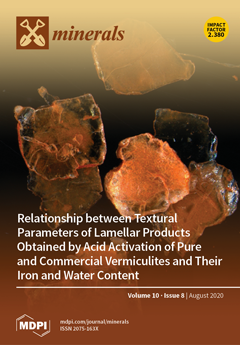An experimental study aimed at the modeling of dolomite- and ankerite-involving decarbonation reactions, resulting in the CO
2 fluid release and crystallization of Ca, Mg, Fe garnets, was carried out at a wide range of pressures and temperatures of the upper mantle. Experiments
[...] Read more.
An experimental study aimed at the modeling of dolomite- and ankerite-involving decarbonation reactions, resulting in the CO
2 fluid release and crystallization of Ca, Mg, Fe garnets, was carried out at a wide range of pressures and temperatures of the upper mantle. Experiments were performed using a multi-anvil high-pressure apparatus of a “split-sphere” type, in CaMg(CO
3)
2-Al
2O
3-SiO
2 and Ca(Mg,Fe)(CO
3)
2-Al
2O
3-SiO
2 systems (pressures of 3.0, 6.3 and 7.5 GPa, temperature range of 950–1550 °C, hematite buffered high-pressure cell). It was experimentally shown that decarbonation in the dolomite-bearing system occurred at 1100 ± 20 °C (3.0 GPa), 1320 ± 20 °C (6.3 GPa), and 1450 ± 20 °C (7.5 GPa). As demonstrated by mass spectrometry, the fluid composition was pure CO
2. Composition of synthesized garnet was Prp
83Grs
17, with main Raman spectroscopic modes at 368–369, 559–562, and 912–920 cm
−1. Decarbonation reactions in the ankerite-bearing system were realized at 1000 ± 20 °C (3.0 GPa), 1250 ± 20 °C (6.3 GPa), and 1400 ± 20 °C (7.5 GPa). As a result, the garnet of Grs
25Alm
40Prp
35 composition with main Raman peaks at 349–350, 552, and 906–907 cm
−1 was crystallized. It has been experimentally shown that, in the Earth’s mantle, dolomite and ankerite enter decarbonation reactions to form Ca, Mg, Fe garnet + CO
2 assemblage at temperatures ~175–500 °C lower than CaCO
3 does at constant pressures.
Full article





